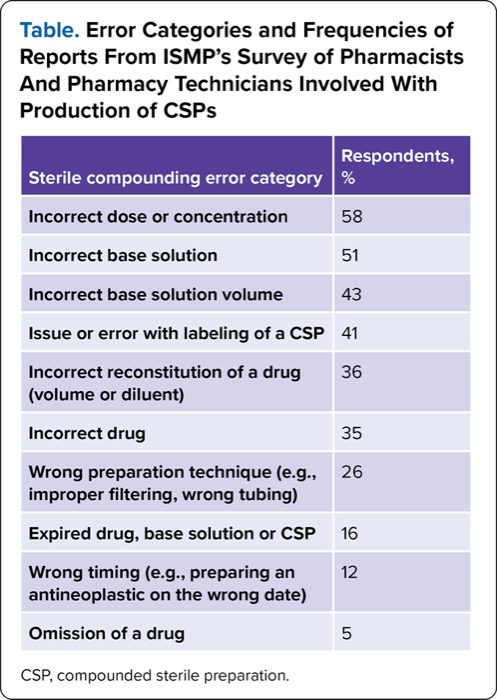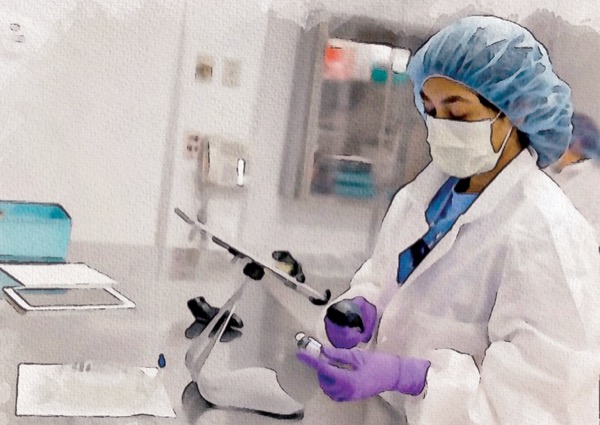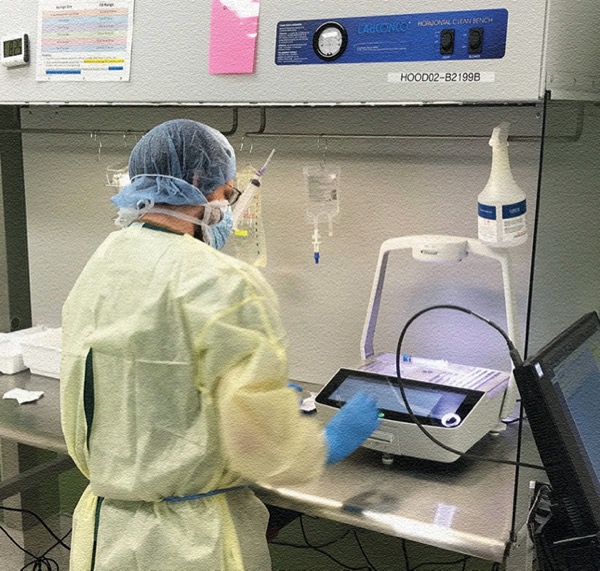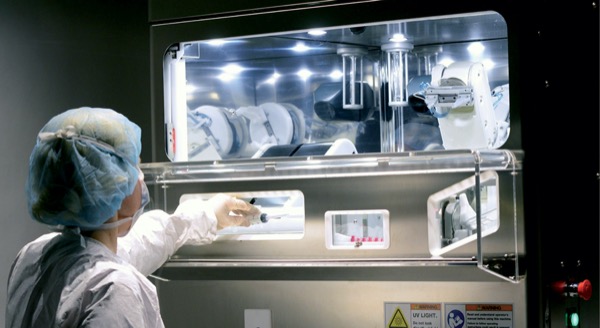Institute for Safe Medication Practices
Plymouth Meeting, Pa.
One of the first things I learned about injectable medications while in pharmacy school was, unlike enteral medications, there was no going back after administration.
Once administered, there was no easily effective means for retrieving that dose. Prior to administration, however, many injectable medications must be manipulated in some way. The simplest of these procedures may involve withdrawal of a dose from a vial by a nurse administering the medication. On the opposite end of the spectrum, we find the extremely complex production of parenteral nutrition (PN) solutions, which requires intricate calculations as well as the addition of potentially dozens of ingredients that must be added in exactly the right volumes and sequence to ensure accuracy and compatibility. Both ends of the spectrum have their risks, but both also commonly use technologies with associated barcode scanning capabilities that allow for the verification of ingredients prior to administration or compounding, respectively.
The automated compounding devices used for PN also employ volumetric or gravimetric measuring systems that can validate the volume or weight, respectively, of ingredients added to the final product. Between these relatively simple doses withdrawn from vials immediately prior to administration and extremely complex productions of PN solutions, lies the remaining bulk of what is produced in pharmacy cleanrooms. These products often involve the reconstitution of lyophilized powder vials with the appropriate volume of the correct diluent, the withdrawal of the correct volumes of these reconstituted solutions, or the withdrawal of other medications available in liquid formulations into syringes for dispensing directly to patients. The products also may be added to infusion solutions ranging from 25- to 5,000-mL bags. These processes are prone to the same risks as the previously discussed ends of the spectrum; however, they often are performed without the aforementioned benefits of technological assistance. Without such assistance, the risk for errors when producing sterile compounding preparations (CSPs) increases. These errors can be attributed to a combination of factors, including:
- complex calculations;
- unit of measure conversions;
- precision of measurements, especially for compounded medications with narrow therapeutic indexes;
- frequent requirement for manipulation of concentrations and formulations; and
- a heavy reliance on human performance and precision.
These processes also are typically found in high-throughput cleanroom environments where the demands related to workload and maintaining aseptic technique can be challenging. In addition, medication shortages are a common disruption in healthcare; for compounded medications, there often is a need for introducing different products or concentrations of ingredients, as well as new procedures or more complex manipulations, when coping with shortages. These additional processes further increase the risk for error. Staffing shortages throw another wrench into the mix because new staff must be thoroughly oriented, trained and display competency for this incredibly complex process. Lack of standard work practices and procedures can make this training, and subsequent accuracy and safety of CSPs produced, highly variable.
Introduction to IV Compounding
Although the first recorded administration of IV therapy dates back to the 17th century, when Sir Christopher Wren used a quill and pig bladder to administer a mixture of wine and ale to his dog, the practice of administering injectable medications to patients did not truly become commonplace in medicine until about 100 years ago when the Pharmacopoeia of the United States contained only two injectables and the National Formulary listed only seven.1,2 In the century since, the list of injectable medications has grown to well over 500, and the practices and technologies used to prepare and administer them have certainly advanced beyond quills and bladders.
In the last 100 years, the preparation of sterile injectables has transitioned from hospitals producing their own large-volume solutions in the 1930s, to largely nursing-driven preparation of all IV admixtures in the 1950s and 1960s, to the largely centralized and pharmacy-driven processes we see today. W.J. Whitfield’s invention of laminar airflow hoods in the 1960s, the growing list of medications and the increasing complexity of compounding processes identified after the first successful administration of PN in 1967 were among the driving forces behind these major shifts in practice.2
Throughout this transition, there were ever-growing concerns regarding the stability and sterility of CSPs. Pharmacy school curricula were adapted to include instruction on sterile compounding; however, to this day many pharmacists and pharmacy technicians gain more advanced training through programs developed by individual institutions or professional organizations. The deaths of more than 100 patients across the country in 1971, linked to contaminated infusion solutions manufactured by Abbott Laboratories, and a number of other deaths in the following decades due to either contaminated or precipitated CSPs, led to the development of guidelines for those engaged in sterile compounding. However, none of these practices were required, until 2004, when USP moved content to the legally enforceable General Chapter <797>.2
Background on Technologies Used For IV Compounding
For most of the aforementioned history, sterile compounding relied on purely manual processes. Although the environments in which CSPs were prepared were advanced through the use of laminar flow, and the tools used improved from reusable glass syringes and bottles to disposable plastic products, these processes all still relied on human calculation and manipulation. Again, the focus of these advances was on product sterility, and not necessarily accuracy. One of the first steps toward safe, accurate and customized care came through the development of automated PN compounders, which allowed for the production of customized macronutrient combinations over the use of standard combinations produced by manufacturers. However, the addition of micronutrients to these solutions was a still a manual process until the release of improved automated compounding devices that allowed for the addition of small-volume injectables to PN solutions in 1991. This was a pivotal advancement in the safe and accurate production of these products through the use of advanced automation.
The next significant advance in safe and accurate CSP production came in 2007, when the first IV workflow management system (IVWMS) was marketed. The following year saw the installation of the first commercialized robotic compounding systems in the hospital setting.3,4 Despite the ability of these technologies to improve the accuracy and safety of sterile compounding practices by helping to identify and prevent medication errors from reaching patients, as of 2022, only slightly more than one-third of hospitals reported use of IVWMS and less than 10% have implemented robotic compounding systems.5
Errors Seen With Compounding (Setting the Stage for IVWMS)
Aside from the aforementioned sterility and stability concerns with the production of CSPs, errors involving the accuracy and safety of these products were also well known and documented. More than 25 years ago, a frequently cited multicenter study made an effort to identify just how often these types of errors occurred. After observing CSP production at five geographically distinct hospitals in the United States, the combined mean error rate for the hospitals was 9%, ranging from 6% to 10%, with wrong dose representing the most common type of error. Upon further review, it was determined that 2% of these errors were judged to be potentially clinically important.6 To put that into perspective, if your pharmacy prepares 500 sterile compounds per day, this would amount to nearly 16,500 total errors per year, more than 300 of which could have a potentially clinically significant impact.
More recently, the Institute for Safe Medication Practices (ISMP) conducted a survey of pharmacists and pharmacy technicians involved with the production of CSPs to identify perceived and observed safety challenges related to sterile compounding practices. Nearly three-fourths of respondents (74%) were aware of at least one error that had occurred in the previous year. The categories of errors identified by the respondents are listed in the Table.7
| Table. Error Categories and Frequencies of Reports From ISMP’s Survey of Pharmacists And Pharmacy Technicians Involved With Production of CSPs | |
| Sterile compounding error category | Respondents, % |
|---|---|
| Incorrect dose or concentration | 58 |
| Incorrect base solution | 51 |
| Incorrect base solution volume | 43 |
| Issue or error with labeling of a CSP | 41 |
| Incorrect reconstitution of a drug (volume or diluent) | 36 |
| Incorrect drug | 35 |
| Wrong preparation technique (e.g., improper filtering, wrong tubing) | 26 |
| Expired drug, base solution or CSP | 16 |
| Wrong timing (e.g., preparing an antineoplastic on the wrong date) | 12 |
| Omission of a drug | 5 |
| CSP, compounded sterile preparation. | |
Although statistics are helpful when analyzing medication errors, it is also important to consider the real-life stories of their consequences. Two sentinel events occurring in the last 20 years highlight this point. In 2006, 23.4% sodium chloride injection was used in place of 0.9% sodium chloride injection to compound a solution of etoposide administered to 2-year-old Emily Jerry, who subsequently died of intense cerebral edema. Her father, Christopher Jerry, created the Emily Jerry Foundation, which has been unyielding in advocating for leveraging technology and establishing best practices in sterile compounding.8 The pharmacist involved with this tragic error, Eric Cropp, was ultimately sentenced to six months in state prison followed by home confinement, probation, community service and a monetary fine.9
In 2014, Loretta MacPherson’s ordered dose of IV fosphenytoin was compounded with the neuromuscular blocker rocuronium instead of the required anticonvulsant medication. The error was not identified during compounding, and the final product was labeled as the ordered drug. Loretta tragically died as a result of this error, prompting a statement from ISMP in a related article: “There is little doubt that IV workflow technologies would have prevented this type of medication error. Now is the time for hospital leadership to support the acquisition of IV workflow technologies that utilize barcode scanning of products during pharmacy IV admixture preparation.”10,11
These events might have been prevented if technologies such as barcode scanning for verification of ingredients had been available during the compounding process. Another sobering similarity in these cases is that there was no way for the administering downstream staff (e.g., nurses and providers) to know that an error had been made, because the product labeling did not reflect the errors made during product preparation.
It can be difficult to identify errors in systems that lack technological support structures. Prior to the implementation of barcode medication administration, there was no technology available to assist practitioners in identifying errors before medication administration. These systems help identify errors in the process and provide a tangible data set for how often these errors occur. These same safety checks are absent throughout the medication-use process for CSPs, despite the fact that sterile compounding is considered the highest-risk process performed in medication preparation for dispensing to patients.
Ultimately, once a medication has been added to a solution or drawn into a syringe, there is no way for downstream users to verify the validity of the product contents, and no detectability of system failures once the product leaves the pharmacy. Despite the safety mechanisms in place for CSP administration, such as bedside barcode scanning, smart infusion pumps and bidirectional interoperability between pumps and electronic health records (EHRs), these preceding system failures are undetectable by practitioners at the point of administration to patients.
In the fast-paced environment of sterile compounding, the introduction of new technologies may seem daunting; however, their utility for managing workflows, increasing efficiencies, standardizing practices and avoiding errors makes them critical for providing safe medications to patients.
ISMP Compounding Guidelines
In response to the aforementioned fatal compounding errors, and numerous other errors reported through ISMP’s National Medication Errors Reporting Program, ISMP convened its first sterile product compounding safety summit and ultimately released Guidelines for Safe Preparation of Compounded Sterile Preparations in 2013, with subsequent revision in 2016. To account for the widening of the compounding technology market that occurred in the decade since its first publication, ISMP convened another multi-stakeholder work group to update the guidelines, with a heavy focus on safe practices related to use of automated compounding devices, robotic compounding devices and IVWMS. The guidelines were released in early 2022, and the recommendations focus on essential attributes of these technologies, safe pharmacy practices for using them and strategies for mitigating harm associated with gaps, or workarounds, identified with these systems.12
IVWMS: What It Is and How It Should Be Used
In the absence of IVWMS, the monitoring of CSP production is an entirely human process, lacking in the same technological support and safety afforded to oral, rectal, topical and other non-parenteral medications. This reliance on human factors effectively reduces the number of individuals who are able to verify the product validity to only those compounding and verifying the product. If the verifying pharmacist is not actively watching product production throughout the preparation, they may rely on outdated, blind trust post-production checks—most commonly, checking of an empty vial and the “syringe pull-back method.” This error-prone process is a proxy and retrospective check, not a direct verification that the correct medication or amount has been added or manipulated, and one that is still being taught in some pharmacy school curricula.
IVWMS help automate the processes of preparing, verifying, tracking and documenting CSPs. The systems bring safety technologies such as barcode scanning into the sterile compounding arena, allowing for verification that the correct ingredients are used in CSP production. Moreover, product libraries can be developed that automatically calculate the required volumes of medications based on their concentrations, thus removing the need for compounding staff to perform these calculations. The systems also can be programmed to instruct staff on the correct volume of diluents to add to drug vials for reconstitution, again removing the burden from, and ensuring consistency of preparation among, sterile compounding personnel. IVWMS also standardize the generation of labels and assigning of beyond-use dates (BUDs), while allowing for real-time electronic images of ingredients and the compounding process at each step. Throughout the compounding process, IVWMS also maintain time-stamp records at each step, as well as recording which users are preparing and verifying each dose. Some systems also allow for the addition of scales for gravimetric verification of ingredients, adding an increased accuracy beyond that of volumetric, or imaged-based verification. Although the focus of this article is on sterile compounding, these systems also can provide these same safety mechanisms in non-sterile compounding areas.13
IVWMS technologies have been steadily evolving since their first introduction 15 years ago in their abilities to standardize workflows, provide documentation of pharmacy cleanroom processes and, most importantly, aid in the safe preparation of CSPs. Although the systems available on the market today vary in their features, ISMP guidelines identify 19 essential attributes as well as 19 associated with safe pharmacy processes. (See box for a selection of some of the most important attributes.)
Ultimately, these systems help identify the incorrect use of CSP source ingredients and other items used for their production (e.g., use of polyvinyl chloride bags for incompatible drugs, incorrect infusion tubing sets, U-100 insulin syringes instead of U-500 insulin syringes); standardize the processes for preparation; and help ensure the accuracy of ingredient measurement, with all of the aforementioned added capabilities and functionalities.
Benefits of IVWMS
The benefits of IVWMS can best be demonstrated by reflecting on the previously mentioned cases and how the outcomes would have been drastically different. If the pharmacy technician preparing Emily Jerry’s dose of etoposide used an IVWMS, it would have alerted them that they had scanned 23.4% sodium chloride in place of the required 0.9% sodium chloride solution to prepare the dose, and would have supplied precise and standardized instructions to follow, instead of relying solely on the technician’s training and experience. In the second case, if that hospital had this technology, it would have alerted the pharmacy compounding staff that they had incorrectly scanned a vial of rocuronium in place of fosphenytoin.
IVWMS also can help better identify manufacturer ingredient expiration dates as well as BUDs of CSPs used as bulk solutions for preparation of other doses to help prevent use of products beyond these cutoffs. In such cases, IVWMS removes the reliance on human diligence in catching these types of errors.
In some systems, time-sensitive or expensive CSPs can be prioritized based on times due, or placed into hold queues to prevent their production too far in advance, reducing the potential need to dispose of them and re-prepare. Settings also may allow for identifying high-alert medications, such as chemotherapy or human-derived blood products, that then can be set to require an in-line verification. In such a scenario, compounding staff must halt the compounding process until a pharmacist verifies and approves the ingredients before mixing, as well as require pharmacist double checks.
Outside these important reductions in errors and subsequent patient harm, these systems have other potential benefits. Although cost is often cited as an implementation barrier, IVWMS can help reduce waste and errors, both of which may yield savings and thus partially offset the initial investment needed to launch these systems. Also, as with any type of informatics-based system, IVWMS may be able to provide various readily accessible reports. Reports on product usage, for example, can be incredibly helpful when managing drug shortages, aid in adjusting batched product par levels based on historical usage statistics and ultimately reduce waste. In addition, data regarding production times and workload throughout the day can be helpful when determining needs for workflow changes, or investigating errors involving delays in medication delivery.
IVWMS also can be used to implement many forcing functions, and in many cases, through collaboration with your vendors, programming enhancements may be suggested and implemented specific to your organizational needs. For example, while implementing the use of CSPs for instillation into cerebral ventricular spaces, users are able to work with their IVWMS vendor to develop workflows specific to the “intraventricular” route that reflect different process steps and tools (e.g., use of 0.2-micron filters) that are different from those used for other parenteral routes. This is valuable in ensuring consistent staff preparation without having to rely solely on education.
Challenges With Using IVWMS
As with any other healthcare technology, challenges must be acknowledged and accounted for during IVWMS implementation and ongoing stewardship processes. These systems require careful consideration, planning, initial and ongoing staff training, and the allocation of appropriate available resources to ensure all of your products and master formulation records are accurately programmed before use. Collaboration with IVWMS vendors to ensure ongoing maintenance and upgrades are performed at regular intervals is also important. This is especially important when using systems that incorporate gravimetric analysis, because you must follow guidance from vendors to determine minimum volumes that can accurately be measured, as well as ensure that product densities are obtained from drug manufacturers and are transcribed correctly into the software systems.
It is important that organizations take the time to conduct a failure mode and effects analysis prior to IVWMS implementation, including front-line staff who will use the system, to help identify any potential problems before you go live. Take into consideration the impacts of limiting IVWMS use only for certain high-alert medications. Consider again the aforementioned case where a high-alert medication was incorrectly used to compound a non-high-alert medication dose. Your old manual workflows and processes may not allow for simply dropping these systems into them. You will need to consider how your other processes need to change to work with the new IVWMS, not the other way around. The implementation process also may require buy-in from your staff, so it is important that they have a clear understanding of the immense value and impacts on safety, productivity and cost that these systems offer. From my own experience, there may be hesitancy at first, but within a few months they will question how they ever worked without it.
First and foremost, the implementation of an IVWMS must focus heavily on maintenance of CSP sterility. Systems may require users to leave the direct compounding area (DCA), or interface with touch screens. Initial system testing should include observation of simulated compounding to identify and remove unnecessary breaks in sterility, and account for the necessary ones with appropriate cleaning of the touch-screen interfaces and re-sterilization of gloved hands after breaches. Most systems will have components that reside within the DCA, so you will need to update your cleaning and disinfection procedures to include this equipment. Consult with the manufacturer instructions for use, and make determinations on how they may affect laminar air flow. Work with your cleanroom certifier to perform smoke testing to ensure appropriate first-pass air is not being interrupted. Lastly, include use of your IVWMS in your initial and ongoing sterile compounding competencies to better reflect real-life practice scenarios, particularly the aforementioned sterility breaches and technology interactions.
As previously mentioned, IVWMS use pictures, weights or both to verify ingredients. It is therefore important that you test your cameras and scales to ensure the pictures taken allow for verifying staff to clearly visualize the syringe graduations, and that the scales can record accurate weights despite any vibrations that laminar flow hoods may produce. There have been scenarios where staff have turned off laminar flow hoods to obtain weights, thus compromising CSP sterility.
Because many CSPs may require the use of multiple drug vials, IVWMS should require that every drug and diluent vial used be scanned. Compounding staff using these systems must recognize the importance of scanning each vial used, instead of scanning one vial as a surrogate multiple times as a shortcut or workaround. It is equally important for staff not to use other surrogates, such as empty bags, for scanning, and only scan the actual ingredients or other products being used. Similarly, if a CSP requires that multiple syringes of an ingredient be drawn up, staff should ensure they are including all syringes drawn up in pictures, or weighing each syringe if gravimetric scales are being used, rather than taking multiple pictures or weights of only a single syringe. Because staff may have the antiquated “pull-back” method ingrained into their processes, you also may need to monitor for, and correct, staff injecting medications into infusion bags, and only taking pictures of empty syringes pulled back to the volume injected. Staff verifying compounding should be trained to reject these products and ensure the doses are remade.
Because of ongoing shortages and back orders, ensure you have a process in place to guarantee these products are programmed into your IVWMS before being placed into working stock locations, and that the barcodes are tested to ensure your scanners are able to identify them correctly. This can reduce the need or tendency for staff to bypass scanning, if allowed by the system. Although you likely will not want all of your staff to have the ability to make changes to your IVWMS system, you should identify a small group of superusers, with appropriate training and validation, who can program new drugs into systems when the person in charge is not available.
Anybody who works in healthcare today should be aware of the “alert fatigue” concept. As with every other system used in the provision of safe patient care, limits in IVWMS should be focused on those with the most value. Organizations also should define in their policies, procedures, standard operating procedures and onboarding processes how overrides of system warnings or alerts are to be managed, with the overall goal being to limit them. When possible, second verifications should be built into processes before any warning or alert is overridden or bypassed. These overrides also should be regularly reviewed to determine their appropriateness and help facilitate process improvement.
To ensure the correct label is ultimately applied to the final product, compounding staff should only prepare one product at a time, and the dispensing label should only be printed and applied after completion of the product. If your system uses separate production and dispensing labels, the application of the final dispensing label should be verified by machine-readable coding to ensure it is placed on the correct product. Facility standard operating procedures should be developed to outline these processes and prevent the unnecessary reprinting of extra production and/or dispensing labels. The labels also should be designed to include any pertinent auxiliary product information (e.g., storage conditions, product handling, administration warnings) to ensure the appropriate information is not inadvertently forgotten or excluded.
Finally, there is a reason why IVWMS systems are sometimes referred to as semiautomated. Although they add a much-needed level of safety to the high-risk process of sterile compounding, they cannot replace human intuition and knowledge. To date, these systems may not be able to detect whether a dose is correct, so staff must be aware of this limitation and avoid the tendency toward automation bias, an overreliance on automated aids and decision support systems. Even though the system will not reject a dose of vancomycin 10,000 mg, this does not mean that it is correct. Although IVWMS can detect the majority of compounding errors, some studies have shown that a significant number are still detected by pharmacists during the final compounding checks.14 You can think, rather simplistically, of IVWMS as very fancy printers. They are able to receive information from your EHR and perform the necessary subsequent tasks, but they often may not have the higher-level computing capabilities beyond this.
Conclusion
The compounding of sterile medications for parenteral administration to patients is not a new process. Its history has involved numerous important transitions, many of which have been, unfortunately, sparked by errors and harm to patients. Most of the last century has been focused on the sterility and stability of these products, which ultimately led to the development of regulations and standards to ensure their consideration, but the last several decades have shown an equally important heightened focus on accuracy and safety. Ultimately, use of an IVWMS should be the minimum safety standard for preparing all CSPs; however, appropriate resources are needed to implement and maintain them successfully and safely, and ensure processes are in place to identify and troubleshoot potential workarounds. At the very least, we need to advocate that sterile compounding curricula move away from teaching outdated processes such as the syringe pull-back method and adequately prepare future compounders to use safe compounding practices and available technologies, with an understanding of the potential workarounds and how to identify and avoid them.
Let’s not wait another 100 years before changes are made.
References
- Shamsuddin AF. Brief history and development of parenteral nutrition support. Malaysian J Pharmacy. 2003;1(3):69-75.
- Myers C, Anderson D, Barker KN, et al. History of sterile compounding in U.S. hospitals: learning from the tragic lessons of the past. Am J Health Syst Pharm. 2013;70(16):1414-1427.
- Drug Topics. Baxa DoseEdge upgrade features many key improvements. Published December 16, 2010. Accessed May 1, 2023. https://www.drugtopics.com/view/baxa-doseedge-upgrade-features-many-key-improvements
- Hansen NE. Pharmacy IV automation a mature, proven technology. Today’s Medical Developments. Published August 14, 2013. Accessed May 1, 2023. https://www.todaysmedicaldevelopments.com/news/pharmacy-medical-technology-automation-081413
- Paytes A, Hansen KN, Boiallis CJ. The state of sterile compounding technology. Pharmacy Purchasing & Products. March 2022;19(3). Accessed May 1, 2023. https://www.pppmag.com/article/2893
- Flynn EA, Pearson RE, Barker KN. Observational study of accuracy in compounding i.v. admixtures at five hospitals. Am J Health Syst Pharm. 1997;54(8):904-912.
- Institute for Safe Medication Practices. ISMP survey provides insights into pharmacy sterile compounding systems and practices. Published October 22, 2020. Accessed May 1, 2023. https://www.ismp.org/resources/ismp-survey-provides-insights-pharmacy-sterile-compounding-systems-and-practices
- McCoy K, Brady E. Rx for errors: drug error killed their little girl. USA Today. Updated February 21, 2018. Accessed May 1, 2023. https://emilyjerryfoundation.org/rx-for-errors-drug-error-killed-their-little-girl
- Institute for Safe Medication Practices. Eric Cropp weighs in on the error that sent him to prison. Published December 3, 2009. Accessed May 1, 2023. https://www.ismp.org/resources/eric-cropp-weighs-error-sent-him-prison
- Ross M. Pharmacy worker’s error leads to hospital patient’s death. Pharmacy Times. Published December 10, 2014. Accessed May 1, 2023. https://www.pharmacytimes.com/view/pharmacy-workers-error-leads-to-hospital-patients-death-
- Institute for Safe Medication Practices. Tragic error with neuromuscular blocker should prompt risk assessment by all hospitals. Published December 18, 2014. Accessed May 1, 2023. https://www.ismp.org/resources/tragic-error-neuromuscular-blocker-should-prompt-risk-assessment-all-hospitals
- Institute for Safe Medication Practices. Guidelines for sterile compounding and the safe use of sterile compounding technology. Published May 4, 2022. Accessed May 1, 2023. https://www.ismp.org/resources/guidelines-sterile-compounding-and-safe-use-sterile-compounding-technology
- Institute for Safe Medication Practices. Maximize benefits of IV workflow management systems by addressing workarounds and errors. Published September 7, 2017. Accessed May 1, 2023. https://www.ismp.org/resources/maximize-benefits-iv-workflow-management-systems-addressing-workarounds-and-errors
- Deng Y, Lin AC, Hingl J, et al. Risk factors for i.v. compounding errors when using an automated workflow management system. Am J Health Syst Pharm. 2016;73(12):887-893.
Copyright © 2023 McMahon Publishing, 545 West 45th Street, New York, NY 10036. Printed in the USA. All rights reserved, including the right of reproduction, in whole or in part, in any form.

Download to read this article in PDF document:![]() IV Workflow Management Systems: A Century in the Making
IV Workflow Management Systems: A Century in the Making










